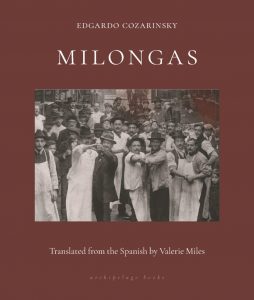
[Archipelago Books; 2021]
Tr. from the Spanish by Valerie Miles
In 1973, a young Edgardo Cozarinsky won a literary contest for an essay in which he argued that the works of Henry James, Jorge Luis Borges, and Marcel Proust shared a common origin in gossip. In this essay, titled “El relato indefendible (The Indefensible Story),”Cozarinsky analyzed, among other examples, James’s cultivation of the “germ” of gossip dropped into conversation, from which entire works like The Spoils of Poynton may emerge. Gossip, the renowned Argentine filmmaker, novelist, and essayist argued, is the foundation of storytelling. According to scholar Ana Rodríguez Navas, gossip functions for Cozarinsky as a refracting prism that allows texts to “discover the plural realities masked, or rendered dilapidated, by our tiresome habit of perceiving reality as ‘una, precisa, tangible.’” Cozarinsky’s latest book Milongas is rooted — or, in this case, afloat — in gossip.
By suggesting that Milongas was written in the spirit of gossip, I mean that Cozarinsky boils the complex and often contradictory history of the dance down to its discrete and essential germs, whose sparks linger in the imagination on account of neither their perceived historical significance nor their verifiable objectivity but their ability to engender delight in their retelling. Cozarinsky himself appears to delight in the subjectivity that shines forth in the primary documents he has gathered in this book-length essay. These constellate the scattered history of a socially and politically embattled dance that has reared its head on multiple continents since its conception in the Río de la Plata regions of Argentina. In fact, Cozarinsky might have seized on gossip as a third term between documentary and fiction, a binary he is known for undoing in his films, which include the drama Les apprentis sorciers (The Sorcerer’s Apprentices, 1977) and the self-proclaimed “documentary fiction” La guerre d’un seul homme (One Man’s War, 1981). By writing in the style of gossip, with its unreliable narrators, its mutations, and retouching, Cozarinsky sketches a history of the milonga centered on passions, intrigues, and oddities rather than on the dry linear progression of the dance’s popularization, suppressions, and revisions.
Milongas is divided into three parts: “The First Move,” “Ceremonies of the Present,” and “Taking Minutes of Bygone Times.” The first section is a preamble that states the emotional stakes of the book for its author, as well as the readership Cozarinsky hopes to find. In it, he writes, “The renewed popularity of tango dancing [. . .] is still viewed askance by opinion-mongers who encourage standards and tastes that prove their ignorance of the dance floor. Milongas is not meant for these self-appointed disciples of Adorno.” Instead, Cozarinsky writes, “This book means to cherry-pick its own readers: not necessarily milonga dancers, but [. . .] people who can’t help but feel moved as their eyes follow the spectacle of a soberly dressed older couple sashaying across the dance floor, unfussy, at three in the morning in some neighborhood dance hall.” These declarations prefigure Cozarinsky’s approach to the rest of the book: to shelter his beloved milonga from the calcifying gaze of critics and historians, Cozarinsky recounts its history like a dancer with his back to the audience. Those sympathetic to his dance follow along and are charmed by his tender, stylized prose and his penchant for inventing new moves.
The second section, “Ceremonies of the Present,” follows a first-person testimony, detailing Cozarinsky’s own experience dancing the milonga. Here, the primacy of the author’s account emerges when he refuses to disguise — and instead highlights — the element of fictionality and the myth-making impulse in his retelling of events. He takes the reader along in his fabulation. For instance, he writes about his search for the perfect “prototype for a fictional character” among the milonga dancers he’s known. He describes the various sites where the dance is held with the gossipy tone of a seasoned patron: “It’s my experience,” he writes, regarding the dances at the quays of the Seine in Paris, “that the more romantic the setting for a milonga, the worse the dancers.” Of note in this section is Cozarinsky’s impressionistic handling of the biography of Argentine tango composer Astor Piazzolla. This passage shows not only Cozarinsky’s vigorous pursuit of historical primacy — getting up close and personal with his subjects — but also the nimbleness with which he is able to imagine his way into scenes from the past. In the span of one short paragraph, the story of Piazzolla leaps from the carnival festivities in Boca Junior’s sports club to a movie set in Paramount’s Long Island studios, providing vivid context for the composer’s “introspective, brooding music.” As a whole, this section moves atmospherically as the author, a self-professed flâneur, drifts from city to city, memory to memory, tracing the migratory patterns of an international phenomenon.
“Taking Minutes of Bygone Times” takes us back in time, to 1913, “the year of tango,” according to H. G. Wells, when the dance was making a splash in France, Finland, Poland, and Italy, and chronicles the spread of the milonga across the globe. This chronicle doubles as a meditation on the question of history and memory. For instance, an essay titled “Unfaithful Memories” opens with the following remark: “Scantily documented for decades, tango historians have had to rely on surviving players as a source, whose memories, as the years inevitably pass, dither, adorn, and omit. Each new testimony, new piece of information I find, seems to open endless new questions instead of bringing closure.” Here, again, Cozarinsky shows his hand as a historian, storyteller, and myth-maker. This section of the book takes on the challenge of debunking famous myths from the milonga’s history. These include the so-called “Vatican episode,” when a pair of married men reportedly demonstrated a tango before Pope Pius X “to prove that there was nothing indecent to the steps and figures of the aristocracy’s preferred rhythm,” a story that Cozarinsky reveals to be less fact than fiction. Each “debunking” in turn reaffirms the notion — Cozarinsky’s own conviction — that myth is preferable to fact. “The legend,” Cozarinsky writes, “would live on [. . .] doggedly.” However, the uncertain conclusions Cozarinsky draws from this anecdote — and from the other narrative “germs” that make up the book — cause the image of the two men dancing before the Pope to remain just that: a germ that never fully blossoms into a story justifying its legendary status.
The book’s third section casts numerous questions and impressions into the air but either neglects or refuses to come down strongly on any central argument; instead, it meanders, gestures, and implies. As a whole, the book does not spend much time stringing the narratives together. It instead lays them out one by one, in a way reminiscent of Susan Sontag’s assessment of Cozarinsky’s most popular work, the novel Vudú urbano (Urban Voodoo, 1985): “Cozarinsky [. . .] has produced [. . .] an album of postcards made of words.” The hyperbolic tone in which the “Vatican episode” is introduced — “Another legendary episode, perhaps the most extravagant in the history of milonga, has also had its legitimacy called into question”— signals to me that Cozarinsky is not trying to debunk legends at all but is instead using criticality as a pretense for recounting the myth in its full grandiosity and even using the historical dispute to further inflate the myth. As a result, the reader learns to approach each anecdote open-mindedly — which is to say, uncritically — and expects to be dazzled. This is a strength of the book, as well as its weakness because without a sustained line of critical inquiry, the “postcards made of words” soon blur into a wash of names and affects. Indeed, Cozarinsky concedes, “It’ll be difficult to destroy the legend” of a “mythical evening,” “no matter how many documents there are that call it into question.” This attitude seems to stem from the author’s deeply rooted conviction and from the emotion he’s invested in the subject at hand.
If one reads Milongas expecting to find a well-researched and deftly written catalogue of memories and primary source accounts, rather than an essay collection that makes and defends specific arguments, then one is sure to delight in Cozarinsky’s latest work. Otherwise, its gossipy tone and Cozarinsky’s impulse to divulge and digress may lose their edge after the first two sections. The book ends with a chapter about famous places where the milonga is danced that leaves on a note of regret and wishful thinking: “I never had the chance,” Cozarinsky writes, “to frequent one of those ‘temples of nocturnal life’” — here, he is referring to the cabarets of Buenos Aires — “whose rituals, though, I conjured in a story.” There is little that is lost between experience and imagination, as the “steps, attitudes, the embrace, and closed eyelids allow one to live a fiction, to act out as characters in a fleeting novel that nevertheless expresses something that’s true, that is no less authentic for being imaginary.” The dance allows the dancer to transcend the categories of fact and fiction and to simply “float inside the body.”
Jenny Wu is a fiction writer and an art historian. Her reviews of art and literature can be found in BOMB, Asymptote, Denver Quarterly, MARCH, and the Los Angeles Review of Books. A recipient of the 2021-23 Tulsa Artist Fellowship, she is based in Tulsa, Oklahoma.
This post may contain affiliate links.






